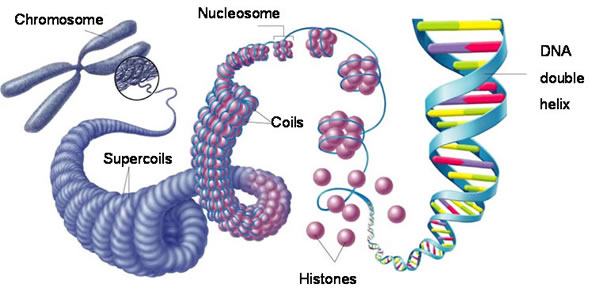The DNA packaging problem
When stretched out into a single layer human DNA reaches up to 2m long, yet the average nucleus of a human cell is only 50μm in diameter. This is known as the DNA packaging problem. This difference in length provides a major problem when trying to fit DNA (https://steemit.com/science/@ovij/what-is-dna-why-do-we-need-it ) into a cell nucleus. Another, less significant problem is that DNA carries a net negative charge, thus the molecules will repel each other when in close proximity. It is clear from these figures that DNA must be coiled to fit into the nucleus, but it also must be bound to a positive molecule so that overall the molecule is neutrally charged. This is overcome by a protein known as a histone.

Histones are positively charged proteins that are attracted to the negative DNA. Part of the role of histones is to form nucleosomes (as shown above). The DNA then wraps around this nucleosome core particle 1.65 times, which is equivalent to 147 base pairs of DNA. Each nucleosome contains 8 histones in total and is comprised of 2 copies each of histones H2A, H2B, H3 and H4 and is therefore referred to as an octamer. Nucleosomes can be situated close together or far apart, leaving parts of DNA completely unwound to allow for transcription to occur with ease.
DNA twisted around nucleosomes can then have further rotation to form supercoils (as shown above). These supercoils aid the DNA in packing into the small nucleus. Enzymes called tropoisomerases can act to modify the local degree of DNA supercoiling, which may be necessary for accessing the bases of DNA during transcription.
Once DNA is coiled into a nucleosome core particle it can interact with another histone called H1 (shown below). This histone acts to introduce a further level of compaction by generating a 30nm fibre with on average 6 nucleosomes per turn. Recent studies into the organisation of DNA in the nucleus have shown that chromosomes as well as entire genomes possess a level of organisation and chromosomes occupy specific regions which were coined chromosome territories.

References:
Image 1: https://pmgbiology.com/tag/chromosome/
Image 2: https://www.fastbleep.com/biology-notes/40/1191
Really cool post, very in formative! I think you'd like some of the stuff I post over on my page!
vote me
nice post @ovij I also have important subjects in science
Thanks, I'll give them a look